1922 — A Year Without Change
In the feature article for the February Monthly Greysheet, Mike Garofalo reviews the coins of 1922 in their centenary year.
The Year was 1922 — One Hundred Years Ago. Warren G. Harding, a Republican from Ohio, was serving as President. The United States had survived World War I, suffering more than 116,000 casualties, but even worse was the Spanish Influenza epidemic killing 675,000 Americans. As the soldiers returned to the home front, they were also battling the Economic Depression of 1920–1921. American unemployment rose because of all the returning troops and the fact that agricultural production was down significantly as farms in Europe recovered from the ravages of war. American exports of farm produce were greatly reduced. Unemployment peaked in 1921 at a high of 11.7%, up drastically from 5.2% in 1920.
However, during this time, the United States Mint had been working feverishly! The 1918 Pittman Act authorized converting up to 350 million of the current Morgan silver dollars back into bullion and the removal of then-circulating paper Silver Certificates, which were backed by the Morgan silver dollars. More than 270 million silver dollars were converted, and most of that subsequent bullion was sold to Great Britain. The British desperately needed this silver bullion to shore up their currency in India. The Germans, during the War, had tried to destabilize the British economy by spreading the rumors that Great Britain did not have the requisite silver to back its own Silver Certificates.
But the benefit to America from the Pittman Act was the requirement that the same amount of silver dollars that would be turned into bullion would need new bullion to be purchased from American silver mines. The requirement stated that the silver from the mines would be at the fixed price of $1.00 per Troy Ounce, which was above the market rate. This benefit to the American mine owners was essentially a federal government subsidy to that industry.
The hiatus in striking Morgan silver dollars between 1904 and 1920 in conjunction with the Pittman Act now had the effect of drastically reducing the number of silver dollars available for commerce. While the Eastern merchants were content to use paper currency, most people in the Western United States preferred actual silver coinage. Even in the 1920s, they had no faith in fiat paper currency.
1921 was a watershed year for silver dollar production. The three active mints in Philadelphia, Denver and San Francisco produced more than 86.7 million 1921-dated Morgan silver dollars. But in conjunction with the production of these coins, the Mint also invited a small number of artists to submit new silver dollar designs. The winner of that contest was an Italian-American medalist, Anthony de Francisci, who had designed a coin that would represent America’s peaceful aims.
The outcry for a coin symbolizing America’s strength but also its peaceful nature was deafening. De Francisci gave America what it wanted and needed, and the design was changed without any Congressional sanction whatsoever. In December of 1921, the Philadelphia Mint struck 1,006,473 of these new coins, which had an unusually high relief as compared to their predecessors. But none of these coins were released to the public until 1922. Now, the primary objective of the United States Mint was to strike these new “Peace” Dollars in sufficient quantity for commerce and to replace those melted under the Pittman Act.
During 1922, the three active United States Mints struck more than 84 million of these new silver dollars, including 35,401 of 1922-dated coins, but using the 1921 high-relief dies with the date changed. The complaints about these high-relief coins were that they were difficult to stack and use in commerce and that a shallower, lower relief design would need to be implemented, which it was. Many of the 1922 high-relief coins were captured at the mint and melted before they were released, but not all. Even with the lower relief on the design of the 1922 Peace silver dollars, the mint was finding it difficult to strike these coins properly, unlike their Morgan predecessors.
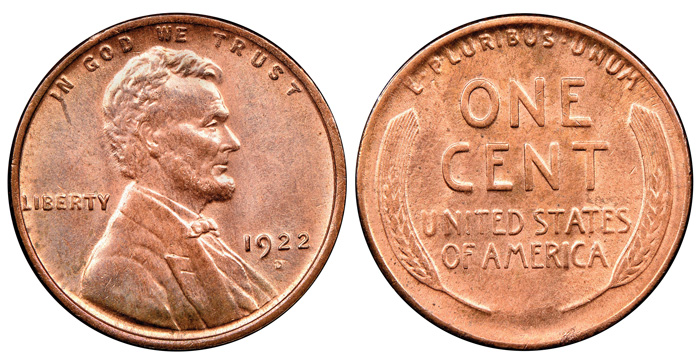
1922-D Lincoln Cent
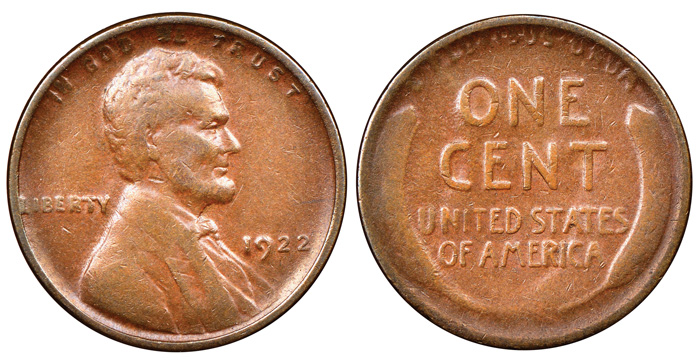
1922 No D “Weak Reverse”
Most of the efforts at all three of the mint locations were directed
towards producing these silver dollar coins. With the exception of 1815,
copper coins had been produced annually by the United States Mint. The
majority of these coins had been produced at the Philadelphia Mint, but
1922 proved to be an exceedingly difficult year in that regard. The San
Francisco Mint had a surplus of more than 15 million undistributed one cent
coins in its vaults and Denver had more than 20 million. Additionally, more
than 54 million Lincoln Cents were struck in 1921 between the Philadelphia
and San Francisco Mints. However, only 7,160,000 Lincoln Cents were struck
in 1922 at the Denver Mint and none were struck at either of the other two
mints.
It is generally believed that the dies for a 1922-dated Lincoln Cent had been created at the Philadelphia Mint and then shipped to Denver for striking. The Denver Mint would also be responsible for adding the “D” mintmark to the die. But somehow, a small number of these coins were struck either using a die that did not have the mintmark or using a very worn die and the mintmark was barely visible or not at all.
These 1922 “No D” coins are exceptionally rare and valuable and there are both “Weak” and “Strong” reverse varieties of the 1922 date. The chart illustrates the Coin Dealer Newsletter wholesale prices for November 2021. The price differential for these coins, all graded Mint State 63, is striking, especially between coins graded RedBrown (RB) and Red (RD).
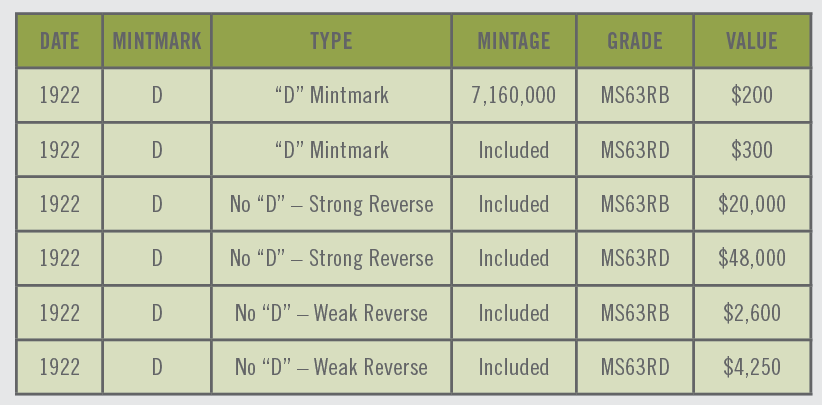
1922 Lincoln Cents wholesale prices courtesy of The Greysheet – November 2021.
But even with a little over 7 million coins struck, Lincoln Cents were well-represented in comparison to other denominations of coins. After striking over 12 million 1921-dated Buffalo Nickels at Philadelphia and San Francisco, none were struck dated 1922. The same was true for Mercury Dimes, Standing Liberty Quarters, and Walking Liberty Half Dollars. The lower mintages are truly indicative of the priority that the United States Mint placed on striking silver dollar coins over all other denominations. These lower mintages are reflected in these values.
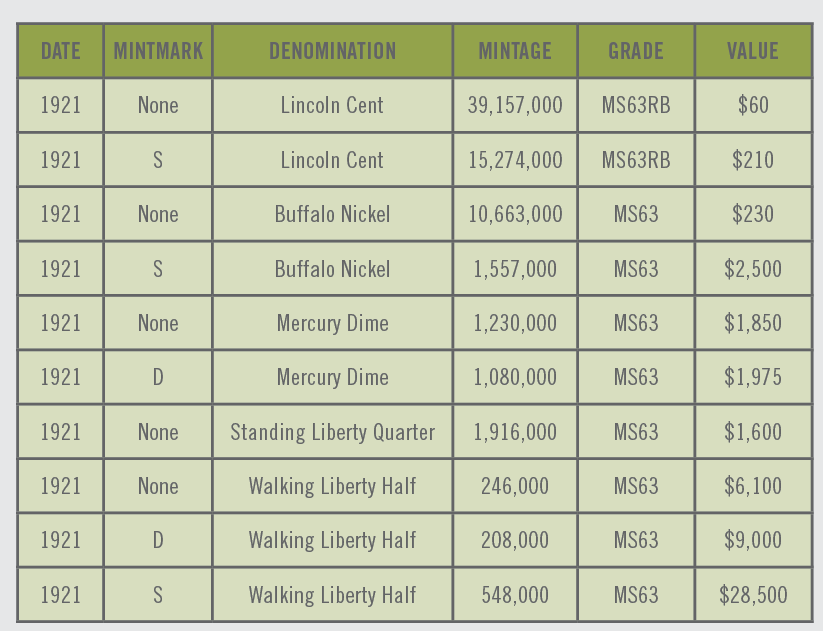
Prices are courtesy of The Greysheet – November 2021.
With low mintage numbers for 1921 and little to no production in 1922 other
than silver dollars, were there coin shortages in commerce? Did the banks
run low on coinage to offer the public?
Hardly! In the 1923 Report of the Director of the United States Mint, Frank Edgar Scobey, Director, reported that there was “$1.5 billion in coinage in circulation” in the United States. So, the true impetus was to produce silver dollars, even if they were difficult to strike properly.
But there was another reason to strike these silver dollars as quickly as possible. The Treasury Department wanted to strike them as quickly as possible to restore the silver coinage that backed these Silver Certificates that the Treasury was issuing. In addition, there were the so-called “Pittman Bonds” which were United States Government One Year Certificates of Indebtedness, issued because of the Pittman Act, which paid 4% interest. The Secretary of the Treasury, Andrew Mellon, took great pains to try to redeem them as quickly as possible in order to attempt to have a balanced budget and before Congress could pass an extension of this silver subsidy.
So where were coin collectors while all of this was happening? The Numismatist, the monthly publication of the American Numismatic Association, took note of the “Summary of Coinage for Fiscal Year 1922” in its August 1922 issue. Only cents, silver dollars and some gold coins were being struck but no mention of dimes, quarters, or half dollars.
In the October 1922 issue of The Numismatist, they quote Mint Director Scobey as stating that “it will probably take two more years to recoin the silver dollars sold as bullion during the war at the rate that purchases of silver are being made under the Pittman Act.”
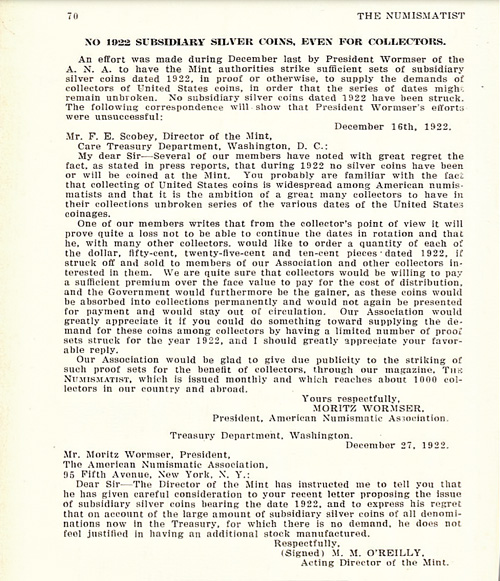
The Numismatist, February 1923 Issue. Courtesy of the American Numismatic Association.
But it was not until the February 1923 issue where the publishers actually
called attention to the fact that no 1922-dated half dollar, quarters or
dimes were being struck for circulation. ANA President Moritz Wormser wrote
a letter to Director Scobey in December, which was published in February
1923 issue, on behalf of the membership of the ANA, about the lack of
“subsidiary silver coinage” for collectors.
President Wormser suggested that the U.S. Mint actually strike some coins for members of the ANA and other coin collectors: “One of our members writes that from the collector’s point of view it will prove quite a loss not to be able to continue the dates in rotation and that he, with many other collectors, would like to order a quantity of each of the dollar, fifty-cent, twenty-five-cent, and ten-cent pieces dated 1922, if struck off and sold to members of our Association and other collectors interested in them.”
But unbeknownst to many collectors, the Philadelphia Mint was striking some additional coinage. 1,375,500 $20 Saint-Gaudens Double Eagles had been struck at the Philadelphia Mint and 2,658,000 were struck at the San Francisco mints during the year.
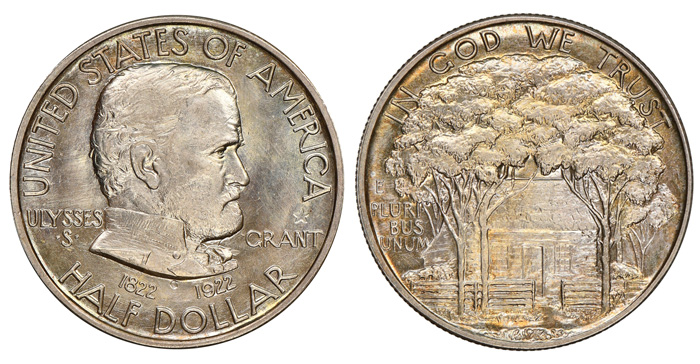
1922 Grant Memorial Half Dollar (with star)
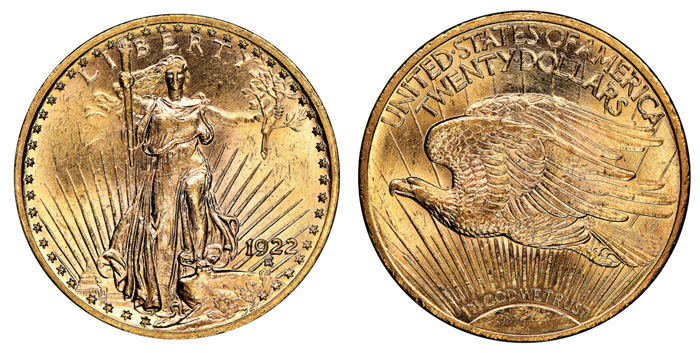
1922 $20.00 Saint-Gaudens Gold Double Eagle
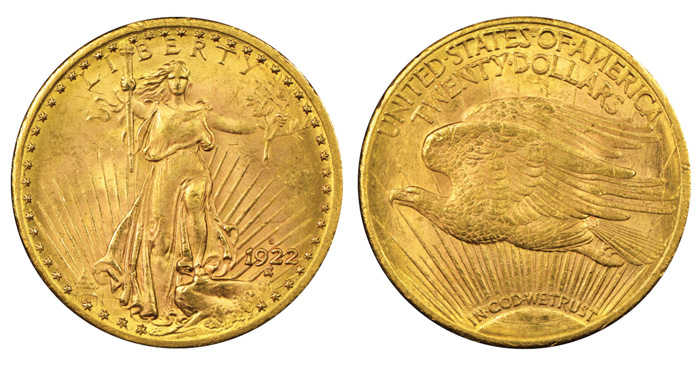
1922-S $20.00 Saint-Gaudens Gold Double Eagle
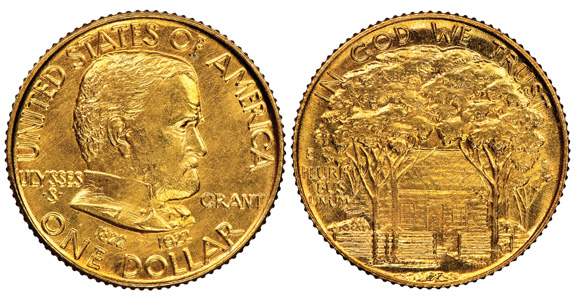
1922 Grant Memorial Gold Dollar (without star)
But there were very few collectors of $20 Gold Coins in 1922. This was,
however, a significant increase in production over the scant 528,500
1921-dated Saint-Gaudens that had been struck in Philadelphia during the
prior year. These coins were, ostensibly, to be used by banks for
transactions between financial institutions.
But those were not the only coins struck by the United States Mints in 1922. There were silver subsidiary coins struck for Costa Rica, Colombia, Venezuela, Nicaragua, and for French Indo-China. But we often forget that there were United States Commemorative coins struck at the Philadelphia Mint as well. In keeping with the theme of limited coinage, only one commemorative issue was struck during the year. But it was struck in multiple collectible varieties.
1922 represented the 100th anniversary of the birth of General Ulysses S. Grant. To honor the former President and Commander of the Union forces, a commemorative half dollar and a commemorative gold dollar were struck. In addition, the first 4,256 half dollars and the first 5,016 gold dollars had an incuse star struck into these coins. The latter strike — 67,405 half dollars and another 5,016 gold dollars — had the incuse star removed creating four separate varieties of these two coins.
These coins were to be designed by a designer of some renown and accomplishment, and it was left to the Commission of Fine Arts (CFA) to render their opinion on any prospective design. The actual selection of an artist to design these coins was left to the sculptor-member of the CFA, James Earle Fraser. Left to his own devices, Fraser wisely and unabashedly chose his wife, Laura Gardin Fraser, who had designed the Alabama Centennial commemorative half dollar, the year prior. Her design met with no objections and the design of both denominations is the same, save for the size and the denomination of each.
Even without any 1922-dated Buffalo Nickels, Mercury Dimes, Standing Liberty Quarters or Walking Liberty Half Dollars, the “Year Without Any Change” proved to be an especially important year for numismatics in America and for the United States Mint.
Photos courtesy of Numismatic Guaranty Corporation,
www.ngccoin.com.

Download the Greysheet app for access to pricing, news, events and your subscriptions.
Subscribe Now.

Subscribe to The Greysheet for the industry's most respected pricing and to read more articles just like this.
Author: Michael Garofalo


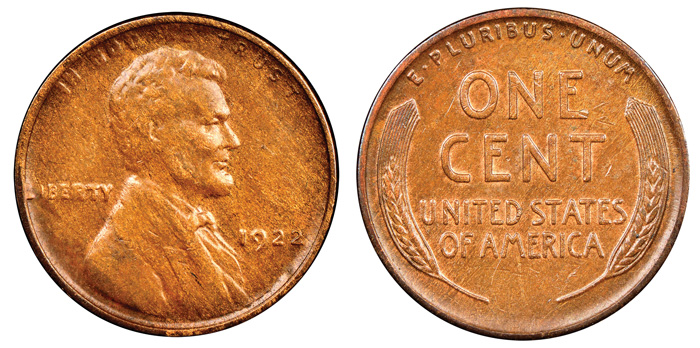






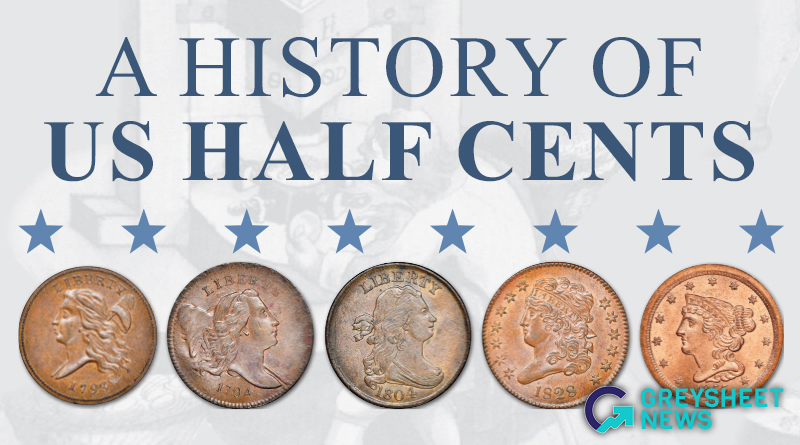
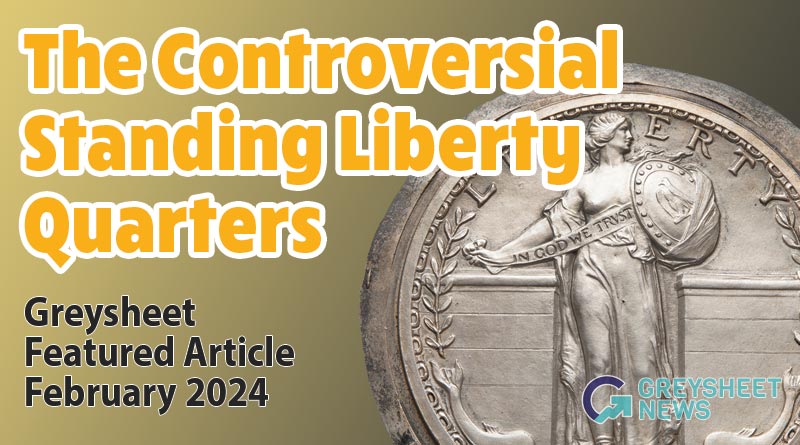
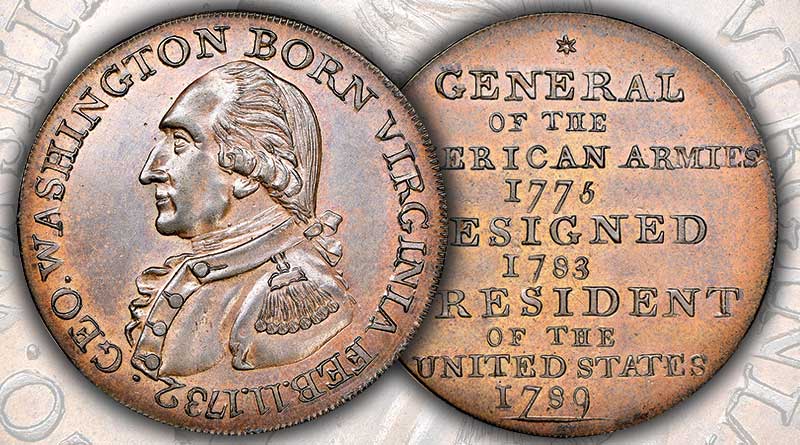
Please sign in or register to leave a comment.
Your identity will be restricted to first name/last initial, or a user ID you create.
Comment
Comments